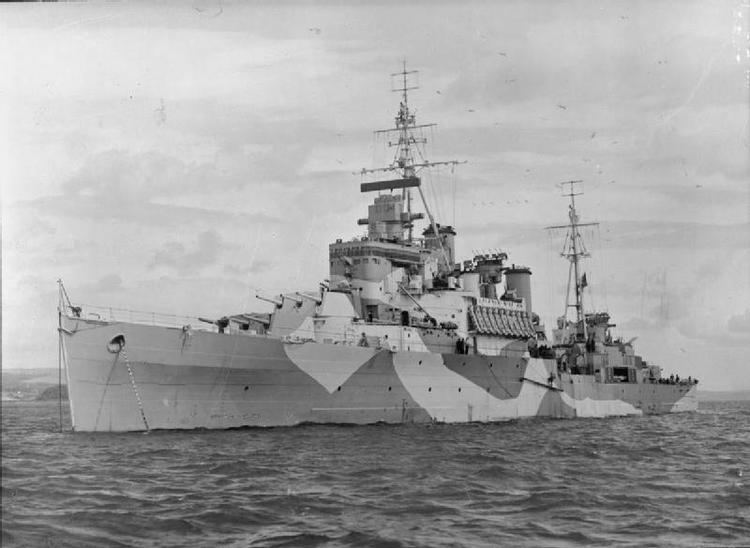Launched 30 July 1942 | Laid down 27 April 1939 Commissioned 13 July 1943 | |
 | ||
Out of service Transferred to Peruvian Navy on 9 February 1960 | ||
HMS Ceylon was a Crown Colony-class light cruiser of the Royal Navy. She was of the Ceylon sub class, named after the island of Ceylon (now Sri Lanka). The cruiser saw service in the Atlantic and Pacific theatres during the Second World War. In the postwar era, she participated in actions in Egypt and the Korean War. In 1960 she transferred to the navy of Peru and renamed Coronel Bolognesi. The cruiser was scrapped in 1985.
Contents
Wartime career
Built by Stephens at Govan and launched on 30 July 1942, she was completed on 13 July 1943. After two months in the Home Fleet she was transferred to the 4th Cruiser Squadron, with the Eastern Fleet and took part in many carrier raids, bombardments and patrols against Japanese-held territory, including Operations Cockpit, Meridian and Diplomat. In November 1944 she joined the British Pacific Fleet and sailed from Trincomalee on 16 January, taking part in a raid on Pankalan Bradan en route. By May 1945, however, she was back in the Indian Ocean, shelling the Nicobar Islands, and remained in that theatre until the end of the war. In October 1945 she returned to England for refit and lay-up.
Postwar
Postwar, she served in the Portsmouth Command during 1946/50, followed by the 5th and 4th Cruiser Squadrons on the Far East and East Indies stations. She was actively engaged in the Korean War, carrying out a number of bombardments. She was paid off at Portsmouth in October 1954 for re-construction.
Her modernisation was largely on the pattern applied to sister ships Newfoundland and Nigeria in 1954-57. The cost of the modernisation of Nigeria (which was later sold to India and served as INS Mysore) was reduced by using mainly sensors and parts originally purchased by the Royal Australian Navy for modernisation of HMAS Hobart before that was cancelled.
The modernisation of Ceylon was simplified by fitting the new 960M LRAW to the original tripod main radar mast rather than fitting a new lattice, less comprehensive electrical refitting and the simplification of fire control systems by not fitting the 275 flypane directors used on Newfoundland and relying on the new MRS8 directors supplied and paid for by the US government similar to that used in updating of the United States Navy's heavy gun cruisers in the 1950s, to control the four twin 4 inch guns, with US MK 63 radar on the mounts the new standard light twin Mk 5 twin L60 Bofors armament on Ceylon had only Simple Tachymetric directors (STD).
After trials with the new equipment, in late 1956, Ceylon was deployed to the Mediterranean where she provided beyond visual range gunfire support to suppress emplaced Egyptian shore batteries at Port Said in support of the British Army and Royal Marine landings. A Communication Officer on the cruiser, describes Ceylon's bombardment as relatively brief, as the Egyptian batteries did not return fire. Later in the operation Ceylon served as an air direction picket, Royalist having been withdrawn and the cruiser Jamaica lacking modern AW AD. Between 1956 and 1959 she served in the Mediterranean, Home Fleet and East of Suez.
Peruvian service
On 18 December 1959, she returned to Portsmouth and was sold to Peru the same month.The disposal of the Ceylon, only three years after its modernisation, came as a shock to its last Captain, Frank Twiss. On 9 February 1960, she was transferred to the Peruvian Navy and renamed Coronel Bolognesi. The sale of her and Newfoundland, while the older Colony and Town cruisers - Gambia, Bermuda, Sheffield and Belfast remained in service or reactivable reserve until the election of a Labour Government in 1964, probably reflected a good price on the sale to Peru and the need for cuts to save the Tiger class. The fact Newfoundland and Ceylon under different names remained in Peruvian service till the 1980s meant some crucial parts for the maintenance of the Tigers were obtained from Peru in the 1970s.
She spent over twenty years with the Peruvians until she was finally deleted from the Navy List in May 1982, and towed to Taiwan in August 1985 to be scrapped.
